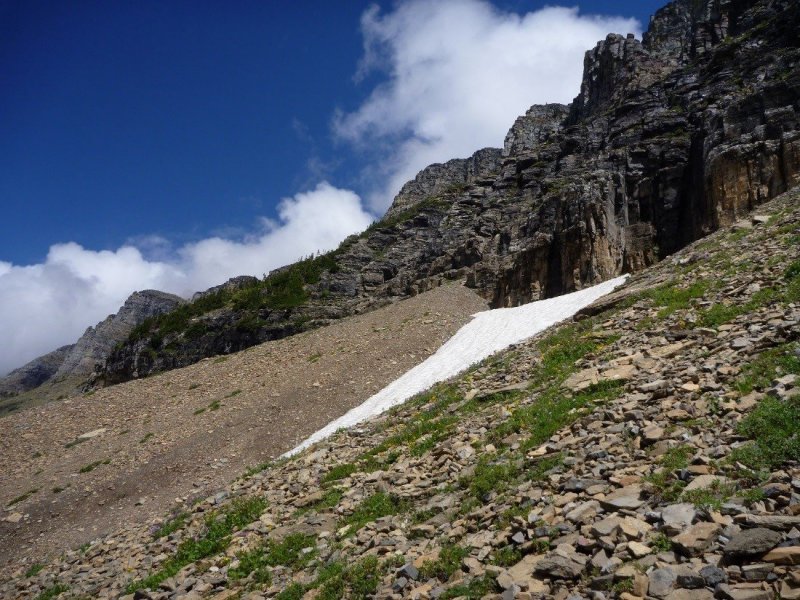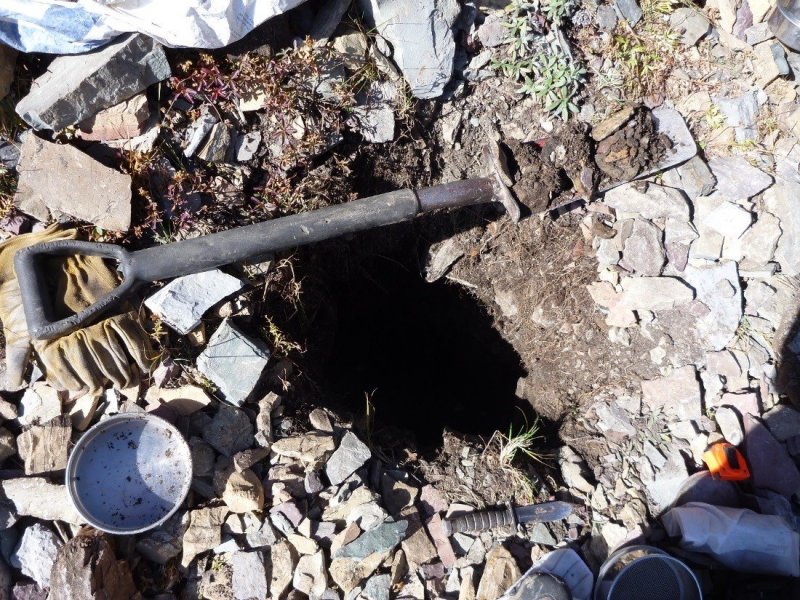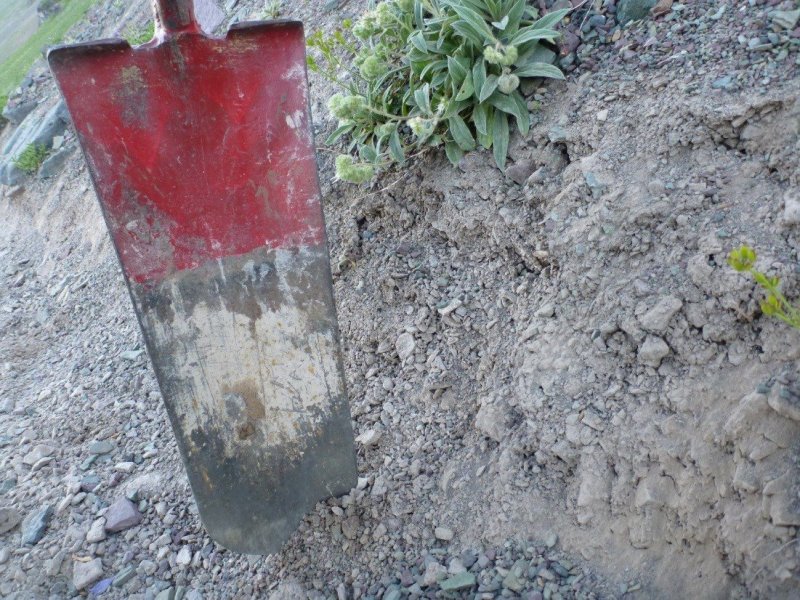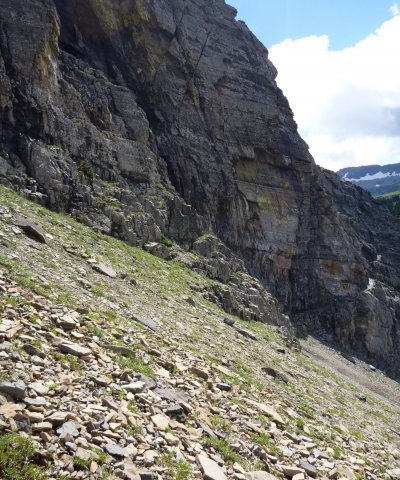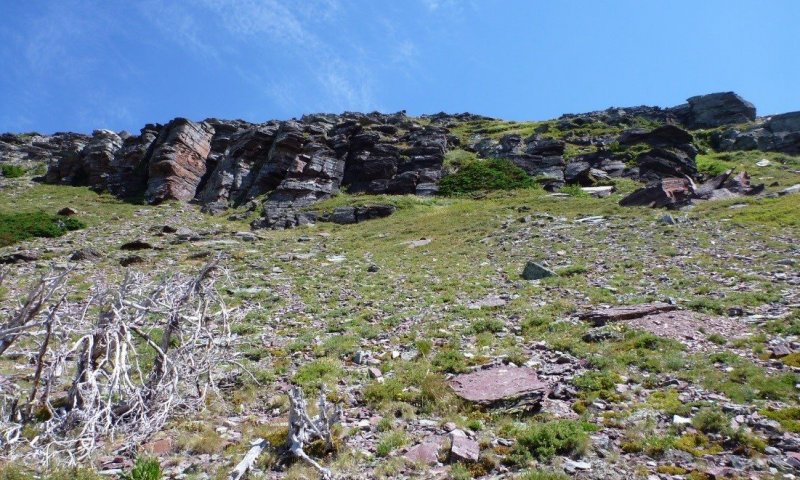

Natural Resources
Conservation Service
Ecological site R043AX962MT
Alpine Unstable Talus rocky ledge penstemon (Penstemon ellipticus)
Last updated: 4/10/2025
Accessed: 12/19/2025
General information
Provisional. A provisional ecological site description has undergone quality control and quality assurance review. It contains a working state and transition model and enough information to identify the ecological site.
MLRA notes
Major Land Resource Area (MLRA): 043A–Northern Rocky Mountains
This MLRA is located in Montana (43 percent), Idaho (34 percent), and Washington (23 percent). It makes up about 31,435 square miles (81,460 square kilometers). It has no large cities or towns. It has many national forests, including the Okanogan, Colville, Kootenai, Lolo, Flathead, Coeur d’Alene, St. Joe, Clearwater, and Kaniksu National Forests.
This MLRA is in the Northern Rocky Mountains Province of the Rocky Mountain System. It is characterized by rugged, glaciated mountains; thrust- and block-faulted mountains; and hills and valleys. Steep-gradient rivers have cut deep canyons. Natural and manmade lakes are common.
The major Hydrologic Unit Areas (identified by four-digit numbers) that make up this MLRA are: Kootenai-Pend Oreille-Spokane (1701), 67 percent; Upper Columbia (1702), 18 percent; and Lower Snake (1706), 15 percent. Numerous rivers originate in or flow through this area, including, the Sanpoil, Columbia, Pend Oreille, Kootenai, St. Joe, Thompson, and Flathead Rivers.
This area is underlain primarily by stacked slabs of layered sedimentary or metasedimentary bedrock. The bedrock formations range from Precambrian to Cretaceous in age. The rocks consist of shale, sandstone, siltstone, limestone, argillite, quartzite, gneiss, schist, dolomite, basalt, and granite. The formations have been faulted and stacked into a series of imbricate slabs by regional tectonic activity. Pleistocene glaciers carved a rugged landscape that includes sculpted hills and narrow valleys filled with till and outwash. Continental glaciation over road the landscape in the northern half of the MLRA while glaciation in the southern half was confined to montane settings.
The average annual precipitation is 25 to 60 inches (635 to 1,525 millimeters) in most of this area, but it is as much as 113 inches (2,870 millimeters) in the mountains and is 10 to 15 inches (255 to 380 millimeters) in the western part of the area. Summers are dry. Most of the precipitation during fall, winter, and spring is snow. The average annual temperature is 32 to 51 degrees F (0 to 11 degrees C) in most of the area, decreasing with elevation. In most of the area, the freeze-free period averages 140 days and ranges from 65 to 215 days. It is longest in the low valleys of Washington, and it decreases in length with elevation. Freezing temperatures occur every month of the year on high mountains, and some peaks have a continuous cover of snow and ice.
The dominant soil orders in this MLRA are Andisols, Inceptisols, and Alfisols. Many of the soils are influenced by Mount Mazama ash deposits. The soils in the area have a frigid or cryic soil temperature regime; have an ustic, xeric, or udic soil moisture regime; and dominantly have mixed mineralogy. They are shallow to very deep, are very poorly drained to well drained, and have most of the soil texture classes. The soils at the lower elevations include Udivitrands, Vitrixerands and Haplustalfs. The soils at the higher elevations include Dystrocryepts, Eutrocryepts, Vitricryands , and Haplocryalfs. Cryorthents, Cryepts, and areas of rock outcrop are on ridges and peaks above timberline
This area is in the northern part of the Northern Rocky Mountains. Grand fir, Douglas-fir, western red cedar, western hemlock, western larch, lodgepole pine, subalpine fir, ponderosa pine, whitebark pine, and western white pine are the dominant overstory species, depending on precipitation, temperature, elevation, and landform aspect. The understory vegetation varies, also depending on climatic and landform factors. Some of the major wildlife species in this area are whitetailed deer, mule deer, elk, moose, black bear, grizzly bear, coyote, fox, and grouse. Fish, mostly in the trout and salmon families, are abundant in streams, rivers, and lakes.
More than one-half of this area is federally owned and administered by the U.S. Department of Agriculture, Forest Service. Much of the privately-owned land is controlled by large commercial timber companies. The forested areas are used for wildlife habitat, recreation, watershed, livestock grazing, and timber production. Meadows provide summer grazing for livestock and big game animals. Less than 3 percent of the area is cropland.
LRU notes
This ecological site resides in MLRA 43A in the Livingston-Lewis-Apgar Mountains which includes the bulk of Glacier National Park (GNP) and the lower western valley portions along the Flathead River. The landscape is mountains and landforms include glaciated mountains with associated features such as U-shaped valleys, mountain slopes, alpine ridges, cirques, valley floors and moraines. Glaciation of this area was in the form of alpine, icecaps and valley outlet glaciers. It also includes associated alluvium and outwash features. This area includes low valleys to tall mountains with elevation ranging 989-2,762 m (3,250-9,050 ft.). The climate is cold and wet with mean annual air temperature of 3 degrees Celsius (37 degrees F)., mean frost free days of 65 days and mean annual precipitation of 1295 mm (51 in.) and relative effective annual precipitation is 169 cm (66 in.). The soil temperature regime is cryic and the soil moisture regime is udic. The geology of this area is dominated by metasedimentary rocks of the Belt Supergroup (Grinnell argillite and Siyeh limestone) with minor Tertiary sediments. Soils are generally weakly developed on mountain slopes within U-shaped valleys. Parent materials are commonly of colluvium, till, and residuum from metasedimentary rocks. Limestone bedrock within this part of the Belt Supergroup is not highly calcareous and due to high precipitation received in this area most carbonates at mid and upper elevations have been leached from the soil profiles. Bedrock depth varies greatly with location, landform and slope position. Volcanic ash is often found in the soil surface with various degrees of mixing. Thicker volcanic ash can be found on more stable positions on mid and upper elevation slopes that are protected from wind erosion. Volcanic ash is not typically found in low elevation areas on stream and outwash terraces associated with streams and rivers. There are numerous large lakes including St. Mary, Bowman, Kintla, Lake Sherburne, Logging, Upper Waterton and numerous creeks (
Classification relationships
NVC Classification: Phacelia hastata-(Penstemon ellipticus) Sparse Vegeation, CEGL005901
Physiognomic Class Sparse Vegetation (VII)
Physiognomic Subclass Boulder, gravel, cobble, or talus sparse vegetation (VII.B.)
Physiognomic Group Sparsely vegetated talus/scree slopes (VII.B.1.)
Physiognomic Subgroup Natural/Semi-natural sparsely vegetated talus/scree slopes (VII.B.1.N.)
Formation High mountain talus/scree (VII.B.1.N.c.)
Alliance Phacelia hastata Sparsely Vegetated Alliance (A.2634)
Alliance (English name) Silverleaf Scorpionweed Sparsely Vegetated Alliance
Association Phacelia hastata – (Penstemon ellipticus) Sparse Vegetation
Association (English name) Silverleaf Scorpionweed- (Rocky Ledge Penstemon) Sparse Vegetation
Ecological Systems: Rocky Mountain Alpine Bedrock and Scree (CES306.809)
Ecological site concept
Ecological Site Concept
This ecological site is found on extensive talus slopes at high elevation near the Continental Divide in the subalpine to alpine life zones. It is found on backslope positions of steep, active and unstable talus slopes with slopes steepness gradients ranging from 35-80%. It occurs on colluvial aprons, cirque walls and glacial valley wall landforms at elevations ranging 1,450-2,700 meters (4750-8850 feet). The reference community describes the site modal concept of unstable scree with little to moderate vegetation development with indicator species including rocky ledge penstemon (Penstemon ellipticus), Buttecandle (Cryptantha celosioides) and silverleaf phacelia (Phacelia hastata). It also has a sparse layer of tall mesophytic forb species including: rocky ragwort (Senecio megacephalus) and yellow columbine (Aquilegia flavescens). Soils associated with this ecological site are deep, well to somewhat excessively drained and have abundant rock fragments throughout. These soils are generally classified in the Entisols or Inceptisols soil orders, indicating that they have virtually no soil development because they are on active positions of the landscape or have only weakly developed soil diagnostic characteristics. These sites are found on active colluvial aprons and glacial valley walls where material is transported down slope by gravity and deposited where the slope angle decreases. Soil development is patchy on these active slope positions, creating a mosaic of areas where more recent depositional activity has occurred juxtaposed against areas that have remained more stable and are more vegetated. Soils on the most recent depositional areas will be Entisols and soils on more stable, vegetated positions will be Inceptisols. Diagnostic features in these soils include an ochric epipedon and cambic subsurface horizon. Soils on these sites typically lack an organic surface layer, but if one is present it is very thin with a thickness of less than 3 cm.
Associated sites
| R043AX963MT |
Alpine Shallow Meadow yellow avalanche-lily-Scouler’s St. Johnswort-alpine leafybract aster-Sitka valerian- heartleaf arnica/Hitchcock’s smooth woodrush The 43A Alpine Shallow Meadow ecological site is found on a wide range of high elevation sites that share in common cold winter temperatures, heavy snow loading, and a short growing season. These are large patch size meadows. These sites are on backslopes, with generally slopes below 35 percent, but can be found on steep backslope positions, and on all aspects. It is found at the base of talus slopes and on large, broad areas on colluvial aprons. It also is found in linear areas between ribbons of high elevation forests found on cirque platforms and headwalls, roche moutonées, or scoured bedrock knobs and hills, and saddles.The 43A Alpine Shallow Meadow ecological site is found on soils that are shallow to moderately deep, well drained, have a high amount of rock fragments, and form from till or colluvium over residuum soil parent materials. These soils very rarely have a surface organic layer, and it is typically less than 5 cm (2 in.) deep if it occurs.The 43A Alpine Shallow Meadow ecological site has a reference vegetation community of Yellow avalanche-lily (Erythronium grandiflorum), Scouler’s St. Johnswort (Hypericum scouleri), alpine leafybract aster (Symphyotrichum foliaceum), Sitka valerian (Valeriana sitchensis), heartleaf arnica (Arnica cordifolia), Hitchcock’s smooth woodrush (Luzula glabrata var. hitchcockii) and shortstalk sedge (Carex podocarpa). |
|---|---|
| R043AX971MT |
Alpine Solifluction Terrace Dryas octopetala (Arctostaphylos uva-ursi/Salix arctica) The 43A Alpine Solifluction Terrace ecological site is found at high elevations (1,700-2,600 m. 5,575-8,530 ft.) on ridges or backslopes in the mountains or cirque floors mainly on northern or western aspects of moderate to steeper slopes (10-40 percent). Due to frost heave action, solifluction terraces have developed, in which there is a sorting of gravels and vegetation into stripes.The 43A Alpine solifluction terrace ecological site has soils that are moderately deep, well drained, and very gravelly in the surface and subsurface. The highest expression of this site has areas of alternating strips covered by vegetation and rock terracing which has low to moderate vegetation cover. The 43A Alpine solifluction terrace ecological site has soils that are moderately deep, well drained, and very gravelly in the surface and subsurface. The highest expression of this site has areas of alternating strips covered by vegetation and rock terracing which has low to moderate vegetation cover. The 43A Alpine Solifluction Terrace ecological site has a reference vegetation community of eightpetal mountain-avens (kinnikinnick-arctic willow-moss campion-twinflower sandwort)/alpine smelowskia-cutleaf daisy-alpine bistort/curly sedge. |
| F043AX954MT |
Upper Subalpine Cold Coniferous subalpine fir (Engelmann spruce) /thinleaf huckleberry-rusty menziesia/ Hitchcock’s smooth woodrush-beargrass/yellow avalanche lily. The 43A Upper Subalpine Cold Coniferous (ABLA/LUGLH) ecological site is found along the continental divide in cold, and moist to moderately dry, high elevations in the upper subalpine. It is primarily on cirque platform and headwall landforms, on backslope and shoulder positions at elevations ranging 1,700 to 2,600 meters (5,575-8,530 ft.) with moderate to steep slopes ranging 10% to 80%.The 43A Upper Subalpine Cold Coniferous (ABLA/LUGLH) has soils associated with this ecological site that are moderately deep, well drained and derived from glacial till or colluvium over residuum weathered from metasedimentary rock. Moderately deep depth class indicates that these soils are greater than 50 cm (20 inches) deep, but less than 100 cm (40 inches). These soils classify in the Inceptisols soil order and in the Typic Haplocryepts taxonomic subgroup. The 43A Upper Subalpine Cold Coniferous (ABLA/LUGLH) ecological site has a reference vegetation community of subalpine fir (and minor Engelmann spruce) with an understory of thinleaf huckleberry, rusty menziesia, Hitchcock’s smooth woodrush-beargrass and yellow avalanche lily. |
| F043AX958MT |
Alpine Krummholtz Coniferous subalpine fir-whitebark pine/grouse whortleberry Abies lasciocarpa-Pinus albicaulis (Picea engelmannii)/Vaccinium scoparium The 43A alpine krummholtz coniferous site is found along the Continental Divide in the severe, cold, high elevations of the upper subalpine and timberline zones. The dominant landform is cirque headwalls, on backslope positions, at elevations ranging from 1,800 to 2,600 meters (5,900-8,530 ft.). This site occurs on all aspects and generally on steeper slopes ranging from 15 to 80 percent.The 43A Alpine Krummholtz Coniferous ecological site has soils associated with this ecological site that are deep and well drained and are on steep mountain slopes. Due to the high amount of rock fragments throughout these soils their ability to hold and store water is limited. Active slope processes and erosion limit the amount of soil development causing these soils to be classified in the Inceptisols soil order. The 43A Alpine Krummholtz Coniferous has a reference vegetation community of Subalpine fir and Whitebark pine overstory (with minor Engelmann spruce) and an understory of grouse whortleberry, thinleaf huckleberry, Hitchcock’s smooth woodrush, beargrass, Green false hellebore, Sitka valerian and Yellow avalanche lily. |
Table 1. Dominant plant species
| Tree |
Not specified |
|---|---|
| Shrub |
Not specified |
| Herbaceous |
(1) Penstemon ellipticus |
Click on box and path labels to scroll to the respective text.
